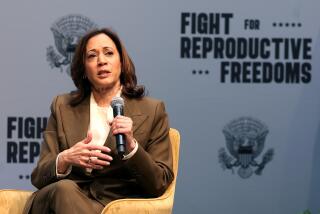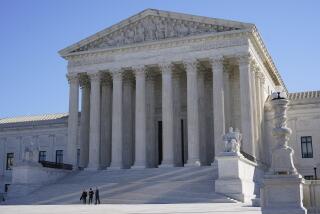Terrorists and the Issue of Abortion : What Will the Bombers Achieve?
WASHINGTON — Christmas Day saw three anti-abortion bombings in Florida, at a clinic and in two gynecologists’ offices. Ten minutes after midnight on New Year’s Eve, a bomb went off in a Washington abortion clinic.
Since May, 1982, there have been 30 instances of anti-abortion arson and bombings across the United States. Three incidents took place in 1982, two in 1983, 24 in 1984 and one already in 1985. So far there have been no deaths or injuries; the bombings usually occur at night, when the premises are deserted.
Nine individuals have been arrested in connection with 12 incidents. The investigation at the federal level is being handled by the U.S. Treasury Department’s Bureau of Alcohol, Tobacco and Firearms. The Federal Bureau of Investigation is assisting the investigation but has declined to take charge, on the grounds that, according to an FBI spokesman, “We have no evidence of any organized conspiratorial enterprise.”
People who call themselves “the Army of God” have claimed responsibility for many of the incidents. One imprisoned member of the Army of God circulated a Christmas letter inviting supporters to use the group’s name in their anti-abortion activities. He claimed that the group was responsible for “229 pickets and other activities against death chambers across the nation.” The day of the Washington bombing, a man claiming to be from the Army of God telephoned a local newspaper to say that the group was responsible for the attack. He offered encouragement to “our brother in Florida” and warned that “the next bombing will be in Ohio.”
The Bureau of Alcohol, Tobacco and Firearms believes that there are only three members of the Army of God and that all are now in jail. The director of the FBI refuses to describe the bombings as acts of terrorism because they do not signify an “attack on government.” Last week President Reagan condemned the bombings “in the strongest possible terms” and committed more federal resources, but not the FBI, to the investigation. As the executive director of the National Abortion Federation put it, “We suspect that if we were talking about a chain of supermarkets that had been bombed to the extent of 29 in one year, we would see an FBI investigation.”
Why have some anti-abortion activists decided to turn to violence? Violence usually signifies hopelessness. People turn to extremism when it becomes clear that legitimate protest is not bringing results.
Their frustration stems from the fact that no real progress has been made toward recriminalizing abortion, even though the Republican Party is committed to that position and has been in control of the White House and Senate for the last four years. What can anti-abortion activists hope to accomplish through violence? Won’t they simply alienate the American public, including many people who are otherwise sympathetic?
The immediate effect of these activities is to frighten women away from abortion clinics and to make it difficult for such clinics to operate. One doctor whose office was bombed in Florida indicated that no one would rent to him because of the insurance risk and that he would have to stop performing abortions at his office.
The larger effect is to keep the issue on the national agenda. Whatever revulsion the public may feel toward the bombings, they do make the point that the issue is not settled. And it is in the Administration’s interest to keep the issue from being settled.
Most Americans do not agree with President Reagan’s position on abortion. In fact, according to a Times poll, a majority of delegates to the Republican National Convention last year were personally opposed to a constitutional amendment to prohibit abortion, even though their party platform called for just such a measure. Still, the Republican delegates approved the platform and President Reagan carried a solid majority of the popular vote.
Polls on the subject of abortion have been remarkably stable for the past 10 years. A substantial majority of the public opposes an anti-abortion amendment to the Constitution. However, a substantial majority also opposes the “pro-choice” idea that a woman should be able to obtain an abortion for any reason. Since 1975, Gallup polls have shown 21%-25% of Americans endorsing the view that “abortions should be legal under any circumstances.” A slightly smaller proportion, 16%-22%, feel that abortions should be “illegal in all circumstances.” A majority of 52%-58% has said consistently that abortions should be legal “under only certain circumstances.”
What circumstances?
Since 1972, the National Opinion Research Center of the University of Chicago has been asking people under what conditions they felt a pregnant woman should be able to obtain a legal abortion. Resounding majorities--three quarters of the public and more--have repeatedly accepted a woman’s right to obtain a legal abortion under three circumstances: “if a woman’s own health is seriously endangered,” “if there is a strong chance of a serious defect in the baby” or “if she became pregnant as a result of rape.”
But most people oppose the right to an abortion “if the family has a very low income and cannot afford any more children,” “if she is not married and does not want to marry the man,” “if she is married and does not want any more children,” or “if the woman wants it for any reason.” What’s the difference between the two sets of circumstances?
The first three involve problems that arise unintentionally--rape, danger to the mother’s health or a serious birth defect. In the other cases, abortion is an intentional choice: lack of money, the desire not to have more children, the desire not to get married, or “any reason.” In each of these situations, the pregnancy was, at least to some degree, a deliberate decision, and the public does not support abortion as a way of getting out of it. In other words, the American public does not endorse abortion as a form of birth control.
Other polls show that about half the public feels abortion is “wrong” but only about a quarter thinks it should be illegal. Thus, most Americans do not accept the contention of the right-to-life movement that abortion is a crime comparable to murder. On the other hand, the pro-choice view that abortion is a human right that cannot be abrogated by the state is not widely accepted either. In the public’s view, abortion is neither a crime nor a right, but an unpleasant practical necessity that is justified by circumstances beyond a woman’s control.
To the extent that the right-to-life movement has defined the issue as a prohibition against all abortions, it has alienated public opinion. In The Times’ nationwide exit poll of voters last Election Day, only 23% endorsed such a prohibition. But among the three quarters who rejected a right-to-life amendment, Reagan still carried a majority of the vote. Disagreeing with the President on this issue did not lead people to vote against him.
Agreeing with him did. The exit polls showed that the minority of voters who made up their minds on the basis of the abortion issue went strongly for President Reagan. In the ABC News poll, 15% of the electorate indicated that their candidate’s stand on abortion was “very important” to them in making their presidential choice. They voted 63% for Reagan. In the survey taken by CBS News and the New York Times, 8% cited abortion as one of the two issues that mattered most to them. They voted 70% for Reagan. Among those for whom abortion is an important factor in deciding how to vote, right-to-lifers clearly outweigh supporters of free choice.
That is why the right-to-life movement has succeeded in “blackmailing” elected officials. A wise politician does not simply count how many people are on each side of an issue. He also tries to figure out how many people on each side will vote for him or against him based on that one issue. While the polls show most voters opposed to a ban on abortions, the polls also show that a candidate is likely to lose more votes by taking a pro-choice position than by voting right-to-life. Thus, even though the Republican Party is on the unpopular side of the abortion controversy, it has probably gained more votes from it than the Democrats have.
The point that the anti-abortion activists, both peaceful and extremist, are trying to make is that abortion is being used as a form of birth control in this country--and that the status quo is therefore unacceptable. Suppose they succeed. One reason President Reagan has been able to get the support of those who disagree with him on the abortion issue is that the right-to-life movement has not succeeded. The status quo has prevailed. If, however, an anti-abortion amendment were to pass Congress, it would certainly mobilize the pro-choice forces and create a sense of threat. Many of those who supported President Reagan and the Republican Party last year, including many young people, would find it difficult to do so again.
So far, President Reagan has been able to have his cake and eat it too. He is helped by those who agree with him and he has been able to overcome his losses among those who don’t. That is likely to remain true only as long as the Administration does not make good on its threat to curtail abortion rights. An Administration victory on the abortion issue would very likely carry with it a significant political cost.
More to Read
Sign up for Essential California
The most important California stories and recommendations in your inbox every morning.
You may occasionally receive promotional content from the Los Angeles Times.










